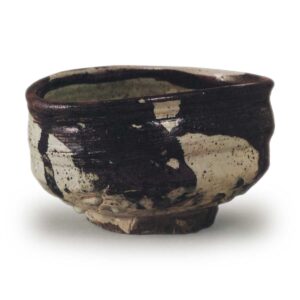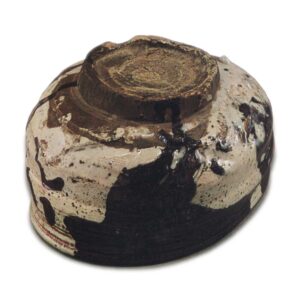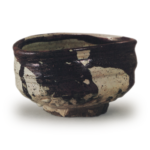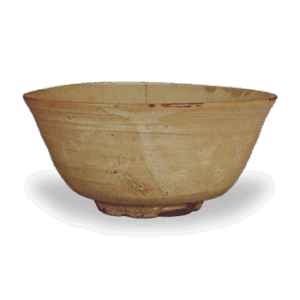

Goshomaru Teacup, “Evening Sun
Important Cultural Property
Collection: Fujita Museum of Art
Height: 6.3-7.5cm
Bowl diameter: 9.8-13.1cm
Outer diameter of stand: 6.4cm
Height of the same: 1.2cm
This bowl is said to be the best of its kind among the black-brush Goshomaru bowls, being the most unrestrained and dynamic in both shape and color. The inscription “Evening Sun” may be named after a faintly reddish spot on the surface of the bowl, which is thought to resemble the sky at sunset.
It is said that the black-brush Goshomaru was made by order from Japan, and was modeled after black Oribe. Although the shape and coloring of the bowl may seem to indicate this, it is not simply following the shape and color of black Oribe, but rather it is a unique Joseon teacup that has absorbed the form of Oribe’s taste and is a strong example of the characteristics of Yi Dynasty potters.
First of all, the molding on the potter’s wheel is excellent. As was the case with the Mino potters who fired Kuro-oriobe, here, too, a familiar, yet sturdy potter’s wheel is the foundation of the molding process. The rise from the waist to the rim extends straight upward, and the body and near the mouth have strongly tightened pressing marks, with coarse or dense wheel-work running between the marks. The mouth has a rounded edge and is slightly open to the outside. Although the shape of the mouth is twisted into a shoe shape, it is not intentional and looks like a natural distortion, and a pleasant sense of tension can be felt at the edge of the mouth. In contrast to the wheel-thrown molding of the upper part, the lower half, from the waist to the base, makes full use of the spatula, and the variation in the size of the spatula is particularly remarkable. This kind of workmanship is always seen in tea bowls of Oribe’s taste, but it is much more intense than that of Oribe’s tea bowls. The shaving of the base is also unusual. The outer surface is large and almost hexagonal, and the inside of the base has been shaved shallowly, and some scratches can be seen on the bottom. The bottom of the bowl has some scratches on it. The rough, unfinished surface is like the surface of a rock.
The base is a white porcelain clay containing trace amounts of iron and sand, and is tightly fired. The surface of the potter’s wheel has several distinctly stepped lines, and the bottom of the potter’s wheel is swirled in a spiral shape.
The glaze is mostly black with some white glaze, but here, iron sand glaze is added on top of the white glaze to create a different effect. The glaze application is crude, bold, and bizarre, in keeping with the workmanship of the base. In particular, around the base, the white glaze is unevenly thickened and hangs down in a milky white color, and there are areas where the white glaze has splashed and lightly blurred, as well as fingerprints. The dark iron glaze, applied in large patches on top of the white glaze, is like an ink trace, spurting out and splashing with excessive vigor. The color tone is not merely black, but depending on the heat, some parts are tinged with red, looking like the color of an akane that has been bathed in the setting sun.
It is said that this black brush is the result of a large, wide brush with a large amount of black glaze applied to it, as if the brush had been used to brush the surface of the piece.
The origin of this piece is unknown; it was in the possession of Shozaburo Kuhara during the Meiji period (1868-1912), and was given to Seigai Inoue in 1905, and moved to the Fujimachi family in 1922. The inner box is made of paulownia wood and sandalwood, and the inscription on the front cover reads “Yuhyo” (evening sun), written by a monk named Etsuki, with an inscription of “Ryoyi” by an old calligrapher.








